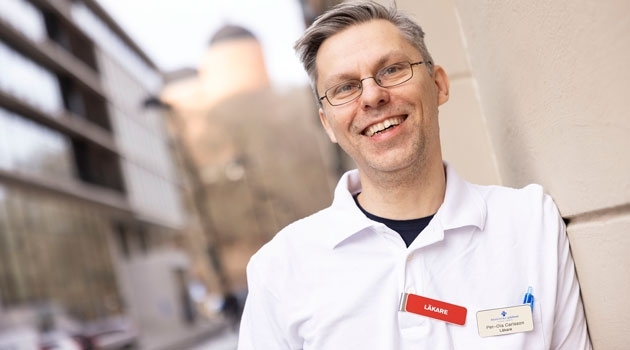Diabetes treatment – from insulin to transplants
This year marks the 100th anniversary of the discovery of insulin. Diabetes, which had previously resulted in certain death, suddenly became treatable. Since then, insulin medications and methods for measuring blood glucose have improved. In the future, researchers hope to cure the disease using stem cells.
Insulin is a vital hormone that regulates blood glucose levels and helps cells absorb nutrients. If your body cannot produce insulin, you will develop diabetes. Before the discovery of insulin in 1921, the disease was tantamount to a death sentence and patients wasted away within just a few months. When it became possible to inject the hormone, however, patients lived several years longer.
“Insulin was first administered to a person in January 1922. The patient who became the first to be treated, a boy, survived for 13 years. It was absolutely amazing. That same year, the first commercial compounds with insulin became available,” says Per-Ola Carlsson, a professor of medical cell biology at Uppsala University.
Insulin has been improved
Photo: Mikael Wallerstedt
Initially researchers used pancreases from animals to produce insulin. They did not begin producing human insulin, using E. coli bacteria, until the 1970s. When more synthetic insulin arrived in the 1980s, it became possible to change the molecular structure so that the hormone was absorbed faster or slower to better meet the patient’s needs.
Insulin is not the only aspect that has been improved. There has also been great progress in techniques for administering the hormone in the body and in the methods for measuring blood glucose levels.
“We have started developing techniques in which glucose sensors and insulin pumps communicate continuously so that the glucose concentration in the blood regulates the infusion of insulin. With these ‘closed-loop’ insulin pumps, patients do not have to give themselves insulin injections. The system sensors maintain the right level,” says Carlsson.
Revolutionary treatments
Future diabetes treatments may be as revolutionary as when insulin was introduced. Researchers around the world are working to ensure that the disease can be cured in the not too distant future.
“The strategies being tested to prevent type 1 diabetes involve working with immunomodulatory therapies that stop the development of diabetes. Other strategies replace the damaged insulin cells in the pancreas with new cells,” says Carlsson.
In transplants of tissue from another individual, it can be difficult for the body’s immune system to accept the new cells and not destroy them. This can be prevented with medications, but these are associated with serious side effects. As a result, Per-Ola Carlsson’s research team is developing a transplant method that does not require immunosuppressive agents.
Transplanting cells
which has been transformed into immature stem
cells and then differentiated into insulin-producing
cells.
“We now have strategies for developing insulin-producing cells from patients’ own tissues – such as a skin biopsy – and reversing their development to turn them into insulin-producing cells. This has proven feasible in animal experiments but has not yet been transferred to humans,” says Carlsson.
He believes that in 10 to 15 years it may be entirely possible to begin transplanting insulin-producing cells from stem cells for use in patients.
“Many companies are developing this in parallel, and we hope that our collaboration will allow us to be first,” says Carlsson.
The Diabetes Centre brings research together
Even though extensive diabetes research is being conducted, we still need more knowledge to fully understand the different diseases included in the concept of diabetes. For example, we do not clearly understand what causes type 1 diabetes and why more and more people are affected. To adopt a more multidisciplinary approach to the subject, Uppsala University established the Uppsala Diabetes Centre at the beginning of this year in collaboration with the Swedish University of Agricultural Sciences (SLU). Various research domains work together here to develop new knowledge about one of our major widespread diseases.
“You can draw a parallel with the development of insulin, where a surgeon and then chemists collaborated in experimental trials and clinical studies. For development to occur, we need many kinds of expertise,” says Per-Ola Carlsson, one of the centre’s initiators.
Åsa Malmberg
Facts: Diabetes
Type 1 diabetes is an autoimmune disease in which the immune system attacks and destroys the insulin-producing cells of the pancreas. It formerly became known as child and adolescent diabetes because it mainly affected children and young adults. No one knows what causes it, but one theory suggests it may be associated with viral infections or environments that are too clean.
Type 2 diabetes, the most common form of the disease, results from insufficient secretion of insulin. Obesity is a major risk factor, but recent research shows that heredity also plays a major role. The process can be impeded with early detection and a change in lifestyle. The disease is increasing rapidly worldwide.
The discovery of insulin
In 1921 Canadian physician and pharmacologist Frederick G. Banting, along with medical student and biochemist Charles H. Best, made a ground-breaking discovery when they succeeded in identifying and purifying insulin. For this, Banting and the laboratory’s director, John Macleod, received the Nobel Prize in Physiology or Medicine in 1923. Believing Best should have received the prize instead of Macleod, Banting gave half of his prize money to Best.

